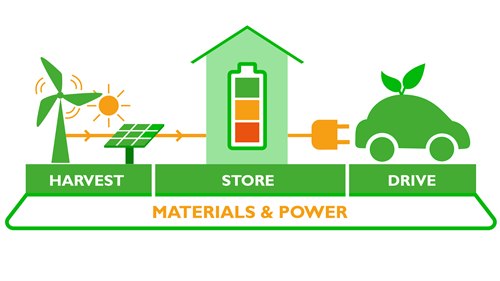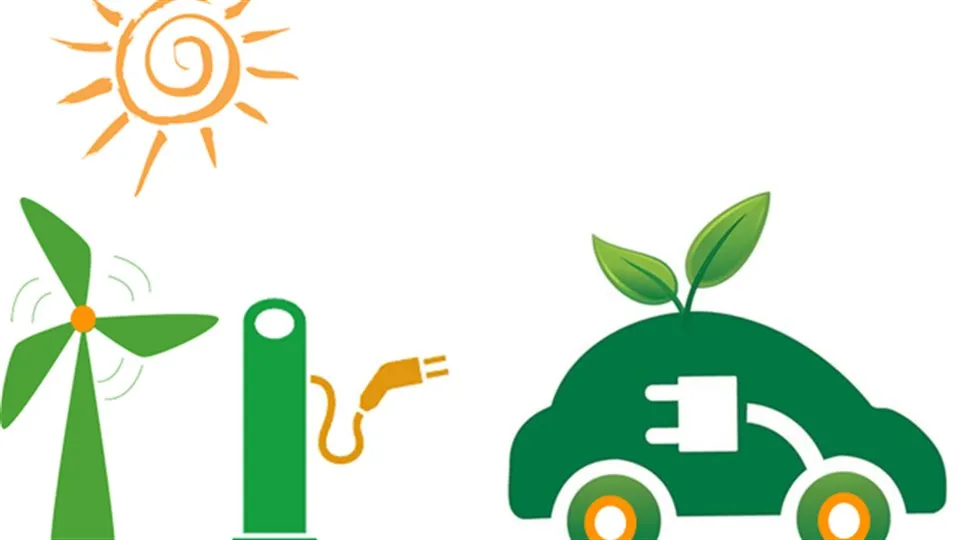One year in the research project DRIVE
We have been driven the research project DRIVE for almost a year. We had planned a green energy seminar in May. But due to the corona pandemic, it is postponed until September 18. See the latest news in the research here on the website. See you in the seminar in September.
Status update to partner companies
Rapid structural transformation takes place in green transport and renewable energy and the growth rate is very high in the green energy sector. To meet tomorrow's demands for green energy and green transport, we conduct the research project DRIVE together with all partner companies. The phase-out of cars with internal combustion engines has begun and many are being replaced by electric vehicles. In parallel, a major expansion of renewable energy production is taking place with solar energy and wind energy. In DRIVE, we focus on research and development in the entire green energy value chain, from the development of energy recovery and energy storage to power electronics and charging infrastructure. The project includes five sub-projects; Harvest, Store, Charge, Drive and Milab.
DRIVE runs between January 2019 and April 2022 and comprises a total of approximately SEK 30 million, half of which is financed by the European Regional Development Fund (ERDF). The remaining part consists of cash from Sundsvall Municipality, Timrå Municipality, Härnösand Municipality, Region Västernorrland and the Swedish Energy Agency, as well as valuable contributions from our business partners.
Main project leader: Dr. Nicklas Blomquist
Deputy Project Manager: Prof. Håkan Olin

Harvesting Energy
Sub project manager: Associate Professor Jonas Örtegren
In the subproject harvest, we develop the next generation of cost-effective and noise-free electricity generation for urban environments.
One area studied in the project is Triboelectric Energy, where Renyun Zhang is a researcher. Tribo energy is about extracting energy that is created when two materials intertwine or rub against each other, so-called static electricity.
During the year we performed modeling and experimental tests with a film that "flutters" in the wind and then touches and charges two electrodes. The modeling has been designed to understand the motion pattern of the film and how wind speed and frequency affect the output power created by the charge of the electrodes. The work has resulted in an article.
Another area that has been studied is Human TENG (Tribo Electric NanoGenerator) where we looked at how to utilize people's movement energy and convert it into electrical energy. Experiments done show that the energy that can be extracted by touching the ground with either the hand or the foot and an electrode can make a large number of LED lamps glow (a few hundred). The studies have been published in two articles.
In support of the research linked to nanogenerators, a new test equipment has been purchased that enables experiments where it is necessary to systematically create mechanical vibrations with different frequency and amplitude and thus measure how a nanogenerator converts the energy from the vibrations to electricity. By doing this systematically one can determine what affects the output power of the nanogen generator. In addition to watching vibrations, the material is also studied where measurements should be able to explain the material's effect on the output power. As far as the material is concerned, a self-made "fully green" material consisting of dissolved and regenerated cellulose has been studied as a nanogenerator where the cellulose is combined with cellophane. These experiments initially show that the self-made cellulose material has 25 times higher electrical signal than in other experiments made with cellulose. Here, further studies will be conducted.

Store Energy
Sub Project Manager Dr Nicklas Blomquist
In the sub-project Store we develop methods for large-scale production of electrode materials and electrodes for supercapacitors as well as new anode materials and processes for Lithium-ion batteries.
Supercapacitors
In today's supercapacitors, porous activated carbon with high surface area coated on aluminum foil is often used as electrode material. We use our own developed low-cost graph, with high surface area and very high conductivity, which allows the electrode to be coated directly on the paper separator with up to 100 times higher production rate.
During the year, a study was conducted in conjunction with the Åbo Academy, where slot-die coating technology was used to try to coat the electrode material on the paper-based separator. In normal cases, the electrode material is coated on the contact, but in this attempt, the separator has been successfully coated with paper, which gives completely new possibilities regarding production rate and cost. The difference in coating speed between coating a smooth contact foil (aluminum or graphite) versus coating a porous paper is on the order of 100 times. The graphene mixture used during the coating is based on the results previously produced at Mid Sweden University. The graphene blend has properties that provide high electrical conductivity, which is a prerequisite for being able to use the large-scale paper coating-based manufacturing process. The study has been published in an article.
Initially, the idea was to be able to carry out large-scale sheet coating at Iggesund Papermill in 2019. These plans have been revised as the attempts made show that the graphene blend used requires a different coating technique to reach the desired amount and thickness of the electrode. To look at alternative coating methods, we have been in contact with UMV in Säffle, a company that designs and sells customer-specific coating equipment, where new large-scale coating attempts are currently underway in their pilot plant. The aim of the tests at UMV, besides being successful with the coating itself, is to obtain a lot of material that can be used for the further work of contacting and stacking to be able to manufacture supercapacitor modules and demos where the idea is to integrate these modules with the electronics from the subproject Charge. Based on a parallel work on optimizing the consistency of the graphene mixture, the hope is to be able to take up the intended experiments at Iggesunds Bruk at a later stage in the project.
Lithium-ion batteries
Graphite is normally used as material in the anode of the lithium ion battery. And it has long been known that silicon can increase the storage capacity of the battery if it is mixed into the anode as silicon can house a significantly larger proportion of lithium ions. In the field, however, there is no method for mixing the silicon which is potentially scalable for industrial production.
During the year, the project worked to develop a process that could be industrially scalable and address the challenges of incorporating silicon into the graphite electrode. In order to make the properties of the silicon particles available and minimize resistive losses, the silicon and graphite must have good contact. The size of the silicon particles must be optimized so that the swelling created when storing lithium does not cause the material to crack. The result of the work is a new method using an airgel mixture of graphite and silicon.

Rohan Patil and Manisha Phadatare, researcher in battery technology at Mid Sweden University.
Charge Energy
Sub-project manager Prof. Kent Bertilsson
In sub-projects Charge, we combine the latest research results in energy storage and power electronics to enable intermediate storage of renewable energy.
During the year, a prototype was developed for a highly efficient DC-DC converter that can handle fast charging of electric cars from energy storage via direct current. The converter needs to handle a varied supply voltage of 20-60V (from the supercapacitor) and supply 400V to the electric car's battery. For this converter, an electronics system has been built to streamline prototype development. In addition to the electronics system, work has been done on the design of, for example, power electronics components and transformers that are part of the system.
A feasibility study has been carried out for the power electronics required for a supercapacitor to be able to supply an electric motor with energy, where the voltage to be used by the motor can be adjusted both based on the voltage of the supercapacitor (based on the charge level) and the voltage required by the motor (based on usage pattern). That is, both the voltage of the supercapacitor and the motor will vary, which places great demands on the power electronics.
The work with power electronics and the engine developed in sub-project Driva has led to talks with vehicle networks in the Gothenburg area, including Chalmers and Volvo, which will culminate in a new conceived project involving the regional company STT Emtec.
Discussions have also been held with the companies Hemab and Sundsvall Elnät based on the role of power electronics and energy storage from the sub-projects may have in a future electricity grid where there are, for example, challenges linked to variation in solar production as the sun goes into clouds. Energy storage coupled with renewable energy such as solar cells creates a need for new thinking about power electronics. In this work, the company Elforest has also been involved based on their knowledge of battery management.

Drive
Sub-project manager Prof. Kent Bertilsson
In sub-project Driva we develop a battery optimized low-voltage motor (below 60V) for electric drives with higher efficiency, compared to existing powertrains for electric vehicles.
During the year, the 3rd generation prototype was designed with voltage in the range 10-20V. Evaluation of this engine has been done with a focus on construction methods for drum and cooling. To make it possible to scale up the engine, the new design has an efficient cooling of the motor windings, which allows the project to go ahead and build a motor with an output power of 300kW and a voltage of 48V. Prototypes of the new motor windings with cooling have been built and are now being evaluated.

MILAB
Sub project manager Dr Magnus Hummelgård
The goal of the Materials and Innovation Lab (MILAB) is to strengthen the University's material research and to coordinate and renew material expertise and equipment for the region's needs, with the aim of creating a space for networking and innovation. During the project, the equipment will be supplemented to support the development of new materials and composites based on nanocellulose, lignin and graphene, but also traditional materials such as cellulose-based fibers or inorganic materials.
During the year, the following equipment was purchased:
- AFM (Atomic Force Microscope): used in surface determination of materials
- Permeability meter: used to determine the permeability of a material
- Test equipment for batteries that increase test capacity
Read more about Supercapacitors
See the publications in the field
